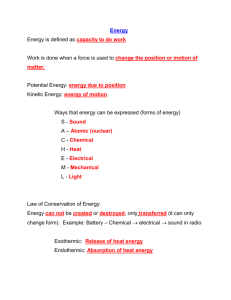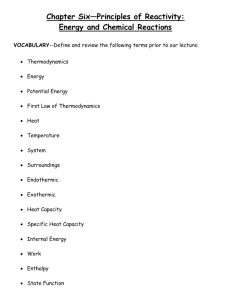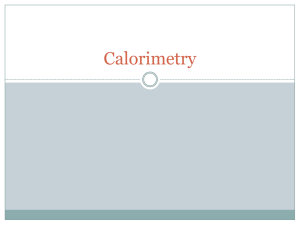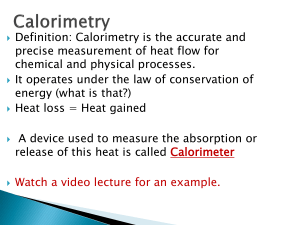Specific Heat Capacity “C”
advertisement
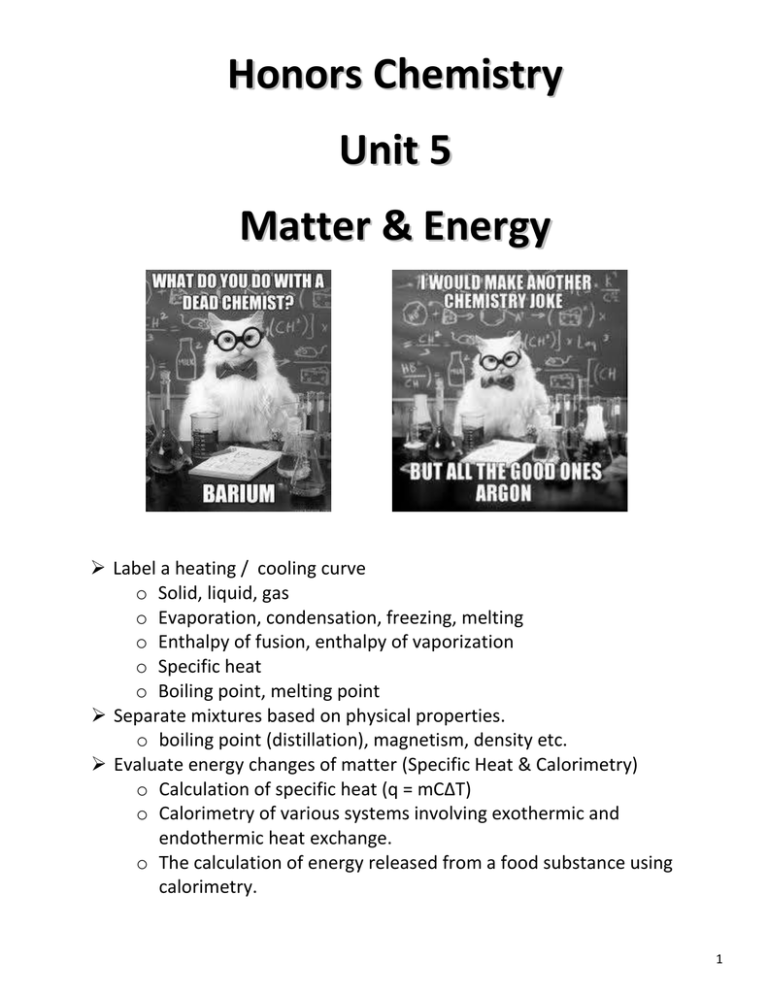
Honors Chemistry Unit 5 Matter & Energy Label a heating / cooling curve o Solid, liquid, gas o Evaporation, condensation, freezing, melting o Enthalpy of fusion, enthalpy of vaporization o Specific heat o Boiling point, melting point Separate mixtures based on physical properties. o boiling point (distillation), magnetism, density etc. Evaluate energy changes of matter (Specific Heat & Calorimetry) o Calculation of specific heat (q = mCΔT) o Calorimetry of various systems involving exothermic and endothermic heat exchange. o The calculation of energy released from a food substance using calorimetry. 1 We are looking for: 1a. Identification of all phase changes and energy change values 1b. Evaporation, condensation, freezing, melting 1c. Enthalpy of fusion, enthalpy of vaporization 1d. Specific heat 1e. Boiling point, melting point 1f. Solid, liquid, gas 2a. Physical properties such as boiling point, magnetism, density etc. 2b. Use boiling point in the distillation process to separate mixture of liquids and identify the liquids present. 3a. Calculations of energy released/gained using specific heat (q = mCΔT) 3b. Calorimetry of various systems involving exothermic and endothermic heat exchange. 3c. The calculation of energy released from a food substance using calorimetry. Matter Objectives: Distinguish between a mixture and a pure substance Describe the states of matter in terms of particles Building Blocks of Matter Atom – smallest unit of an element that maintains the properties of that element. Neutral charge Element – a pure substance made of only one kind of atom Compound – a substance that is made of the atoms from two or more elements that are chemically combined Classification of Matter Pure substance – composed of one kind of atom or molecule has a fixed composition has the same physical and chemical properties throughout Mixture – a blend of two or more kinds of matter Can be physically separated. Methods include: centrifugation, distillation, filtration, and magnets. o Homogeneous – uniform in composition throughout Solution - one or more substances (the solutes) dissolved in another substance (the solvent) Colloid - Particles suspended in a liquid that do not settle out 2 o Heterogeneous – NOT uniform throughout and will show Tyndall Effect (scattering of light due to particles in a solution) Suspension - Particles are suspended in a fluid that will settle out States of Matter: 1. Solid – has definite volume and definite shape. (same shape regardless of its container) 2. Liquid - has definite volume but an indefinite shape (assumes the shape of its container) 3. Gas – has neither a definite volume nor definite shape. (expands to fill any container) 4. Plasma – high temperature state in which atoms lose their electrons. 3 Heating and Cooling Curve Definitions Specific Heat – Solid – LiquidGas – Plasma – Heating Curve Enthalpy of Fusion/ Molar heat of fusion– Melting– Melting Point – Enthalpy of Vaporization/Molar heat of Vaporization– Evaporation– Boiling Point – Sublimation- Cooling Curve – Condensation – Condensation Point – Freezing – Freezing Point – Deposition - 4 The graph below shows the relationship between heat (energy) added, in calories (cal), and temperature for 1 g of water. A student applied heat to 1 g of ice that had been cooled to -40⁰C and measured the rise in temperature. Read and fill-in the notes below and on the following pages and label the steps/regions A, B, C, D, E on the graph. Step A:Solid Water (Ice) Rises in Temperature (Keep in mind the graph is for water!) If the __________________ is not at 0oC, it will rise as heat is ____________to get there. (Kinetic energy is _________________) Each gram of water requires a constant amount of energy to increase 1o = specific heat IMPORTANT – the ice has not________________ yet! Step B: Solid Water (Ice) Melts By ______________energy the ice begins to _____________. Temperature does not ___________ as more energy is being ______________ (Kinetic energy is _____________________ but potential energy is ____________) Each mole of water requires a given amount of energy to melt = molar heat of fusion (∆ Hfus) in kJ /mole. 5 Energy is overcoming water molecules attraction for each other so it can be converted from a solid to liquid. How many calories of energy did it take to completely change the 1 gram of solid water (ice) at 0⁰C to liquid water?________________________ Step C: Liquid Water Rises in Temperature Now the ice is completely _________ and the water temperature begins to _________________ as heat is ________________. (specific heat) Kinetic energy is ______________________. The water has not started to____________ yet. How many calories of energy did it take to make the 1 gram of liquid water to change temperature from 0⁰C to 100⁰C (just beginning to boil)?____________ Step D: Liquid Water Boils As we __________ energy the temperature does not change. Each mole of water will require a constant amount of energy to boil = molar heat of vaporization (∆Hvap) KJ/mole. The energy is being used to overcome water's attraction to each other to convert the liquid to a gas (kinetic energy _________________ but potential energy is _________________). How many calories of energy did it take to make the 1 gram of liquid water to completely turn to steam once it hit 100⁰C?________________________ Step E: Steam Rises in Temperature Temperature ___________ again when all water is turned to steam Each gram of water requires a constant amount of energy to rise 1o = specific heat. 6 Specific Heat Capacity “C” The amount of energy required to be absorbed to warm 1 gram of a substance by 1 oC (or 1 K) or the amount of energy required to be released to cool 1 gram of a substance by 1 oC (or 1 K). -orHow easily things warm up & cool down. Energy Calculations Involving Specific Heat: q = mC∆T where: q = Heat Energy + q means heat/energy is being absorbed (endothermic process) - q means heat/energy is being released (exothermic process). m = mass in grams c = specific heat capacity (also “s”) ∆T = change in temperature (temperature final – temperature initial) Energy Units: Heat energy (q) is in joules(J), kilojoules (kJ) or calories (cal). 1 calorie = 4.184 joules Mass (m) is in grams or kilograms Specific heat capacity, c, is in J/g oC or kJ/kgoC Water (L) = 4.184 J/goC Water (s) = 2.03 J/goC Water (g) = 2.0 J/goC Temperature , T, is usually in oC (temperature can be in K) 7 Metals have low specific heat values Aluminum 0.900 J/goC Iron 0.450 J/goC Gold 0.126 J/goC Doesn’t take much heat to heat them up and they don’t hold the heat well!!! (better conductors of heat/energy) Water and organic materials hold heat much better – have higher specific heats also takes more energy to heat them up. (better insulators of heat/energy) Water = 4.184 J/goC Wood = 1.76 J/goC Specific heats and molar heat capacities for various substances at 20⁰ C Substance J/goC cal/g K or Btu/lb F Molar C (J/mol K) Aluminum 0.900 0.215 24.3 Bismuth 0.123 0.0294 25.7 Copper 0.386 0.0923 24.5 Brass 0.380 0.092 ... Gold 0.126 0.0301 25.6 Lead 0.128 0.0305 26.4 Silver 0.233 0.0558 24.9 Tungsten 0.134 0.0321 24.8 Zinc 0.387 0.0925 25.2 Mercury 0.140 0.033 28.3 Alcohol(ethyl) 2.4 0.58 111 Solid water, Ice (-10 C) 2.05 0.49 36.9 Granite .790 0.19 ... Glass .84 0.20 ... 8 Specific Heat Problems Complete the following on a separate sheet of paper 1. How much heat energy does a copper sample absorb if its specific heat is 0.386 J/g oC, its mass is 12.5 g and it is heated from 25.0 oC to 40.0 oC? 2. How much heat energy is released by 10.0 g of gold, when it is cooled from 35.0 oC to 25.0 oC? The specific heat of gold is 0.129 J/g oC. 3. A 4.00 kg sample of iron was heated from 0.0 oC to 20.0 oC. It absorbed 35.2 kJ of energy as heat. What is the specific heat of this piece of iron? 4. 42.6 J of energy is needed to heat 2.00 grams of carbon from 50.0 oC to what final temperature? The specific heat of carbon is 0.790 J/g oC. Specific Heat Problems2 Complete the following on a separate sheet of paper 1. What amount of heat is required to raise the temperature of 85.9 g of water by 7.0C? 2. When 1045 joules are absorbed by a certain mass of water, the temperature of the water increases from 45.0 ºC to 50.0 ºC. What is the mass of the water sample? 3. How many joules are required to heat 38.0 grams of gold from 60.0 ºC to 260.0 ºC? The specific heat of gold is 0.126 J/(g·ºC). 4. Iron has a specific heat of 0.450 J/(g·ºC). If 1400. joules are absorbed by a chunk of iron that weighs 40.0 grams, how much does the temperature of the iron increase? Specific Heat Problems3 Complete the following on a separate sheet of paper 1. What is the specific heat value of a sample of unknown material, if it weighs 36.359 grams and 59.912 J of heat raise its temperature 152.0 oC? 2. What would be the final temperature of a 73.174 g sample of cobalt with an initial temperature of 102.0 oC, after it loses 800 J? (The specific heat of cobalt is 0.4210 J/goC) 3. What mass of iron would release 0.1854 kJ when its temperature changed from 1550.0 oC to 75.0 oC? (The specific heat of iron is 0.450 J/g oC) 4. The specific heat of mercury is 0.0335 cal/g oC. If 152.00 g of mercury at 75.0 oC are cooled to 23.5 oC, what is the value of q in Joules? 5. Kelly has 2.00 kg of water at 80.0 oC and wants it to cool to 45 oC. If the water releases 20.9 kJ of energy every minute, how long will it take to cool? 9 Calorimetry From the point of view of the system Endothermic Exothermic Feels cold Feels hot Surroundings lose heat (energy) Surroundings gain heat (energy) System gains energy System loses energy (+) Energy term Energy is absorbed (-) Energy term Energy is released Measured in Joules Measured in Joules To convert between Joules and Calories: 1 calorie = 4.184 Joules 10 Calorimeter Q water = -Q system Mass H2O x CH2O x ∆TH2O = Mass sys x Csys x ∆Tsys Mass H2O x CH2O x ∆TH2O = Mass sys x Csys x ∆Tsys 11 Calorimetry Lab Name:________________________________________ Class Period:_______ Purpose: Using the Law of Conservation of Energy, energy transfer, and a calorimeter, you will determine the specific heat value for a given solid sample. Materials: coffee cup calorimeter 400 mL beaker water Procedure: thermometer ring stand balance solid sample 2 metal rings crucible tongs Bunsen burner wire gauze 1) Set up a boiling water bath: a. Set up a double ring stand with the wire gauze to support the beaker. b. Fill the 400 mL beaker about half full with water and place it on the wire gauze/double ring setup. c. Light the Bunsen burner to heat the water to boiling. 2) Determine the mass of your solid sample. 3) Carefully place the solid sample into the boiling water bath. 4) Add about 100 mL of room temperature water from the sink to the calorimeter and determine the mass of the water used. This is best done by placing the empty calorimeter on the balance and taring/rezero the balance then adding the water. 5) Determine the initial temperature of the water in the calorimeter to the nearest 0.1⁰C . 6) After the solid has been in the boiling water bath for at least 5 minutes, remove it and carefully place it into the calorimeter and quickly place the lid on the calorimeter. 7) Gently swirl the calorimeter with the thermometer in it for several minutes while monitoring the temperature of the water inside. Record the highest temperature reached to the nearest 0.1⁰C. *Do not let the thermometer rest on the metal or sides of the calorimeter.* 8) Remove the solid and place it back into the boiling water bath to heat it up for the next trial. Repeat steps 4-7 for two more trials. Data Table: Trial 1 Trial 2 Trial 3 Mass of solid (g) Mass of water in the calorimeter (g) Initial temperature of the solid (⁰ C) Initial temperature of the water in the calorimeter (⁰ C) Final temperature of the water in the calorimeter and the solid (⁰ C) Change in temperature for the solid (⁰ C) Change in temperature for the water in the calorimeter (⁰ C) 12 Analysis: Calculate the specific heat of the solid sample for each trial. (show your work!) Trial One: Trial Two: Trial Three: Average specific heat of the solid: _____________________ You the chart of specific heat values in your packet to try to identify your solid._______________________ Explain why the specific heat value you determined in the lab is lower than the real value for the solid: 13 Calorimetry Problems Complete the following on a separate sheet of paper 1) A 2.8 kg sample of metal with a specific heat of 0.43 kJ/kg°C is heated to 100.0°C and then placed in a 50.0g sample of water at 30.0°C. What is the final temperature of the water and the metal? 2) The specific heat of mercury is 0.033 cal/g°C. If 152g of mercury at 75.0°C is placed in 145g of water at 23.5°C, what will be the final temperature of the water? 3) A 37.7 g piece of metal is heated to 100.0C and placed into 75.0 g of water in a coffee-cup calorimeter. Initially, the temperature of the water in the calorimeter was 23.1C. After the metal was added to the water the temperature of the water increased until its temperature and the temperature of the metal were 30.6C. a. What is the specific heat of the metal? b. What kind of metal was added to the water in the calorimeter? 4) A 440.00 g sample of mercury (specific heat = 0.140 J/goC, initial temperature of 22.00oC) is placed into 134.00 g of water (initial temperature of 35.00oC). Find the final temperature of the system. 5) Abbey is testing her baby’s bath water and finds that it is too cool, so she adds some hot water from kettle on the stove. If Abbey adds 2.00 kg of water at 80.0°C to 20.0 kg of water at 27.0°C, what is the final temperature of the bath water? 6) Jason is emptying the dishwasher. He removes a 0.200 kg glass that has a temperature of 30.0°C. Into the glass, he pours 0.100 kg of diet soda (mostly water) which comes out of the refrigerator with a temperature of 5.00°C. Assuming no external heat loss, what will be the final equilibrium temperature of the glass of diet soda (no ice was added)? (c for glass =0.84 J/g°C). More Calorimetry Problems Complete the following on a separate sheet of paper 1) 45.3 g of a shiny metal, with a specific heat of 0.561 cal/g ⁰C, is placed into a water bath that has a temperature of 99.7 ⁰C. It is then placed into a calorimeter that has 54.7 mL of water. If the water and the metal end up with a temperature of 17.2 ⁰C, what was the initial temperature of the water in the calorimeter? 2) A metal with a mass of 97.4 g is heated to a temperature of 81.4 ⁰C. It is then placed into a calorimeter containing 0.246 kg of benzene, which has a specific heat of 1.74 J/g ⁰C. The temperature of the benzene rises from 15.5 ⁰C to 32.5 ⁰C. What is the specific heat of the metal in calories? 3) A metal with a specific heat of 0.126 cal/g ⁰C is placed into a water bath with a temperature of 94.5 ⁰C. The metal is then placed into a calorimeter containing 86.5 g of acetic acid at a temperature of 20.6 ⁰C. The acetic acid and metal have a final temperature of 35.5 ⁰C. The acetic acid has a specific heat of 2.05 J/g ⁰C. What is the mass of the metal? 4) A metal with a specific heat of 2.03 J/g ⁰C and a mass of 68.5 g is placed into a hot water bath with a temperature of 74.5 ⁰C. The metal is then placed into a calorimeter containing acetic acid at a temperature of 14.5 ⁰C. The final temperature of the acetic acid and metal is 45.5 ⁰C. The density of acetic acid is 1.04 g/mL and a specific heat of 0.49 cal/g ⁰C. What is the volume of acetic acid in the calorimeter? 14 Distillation To separate a mixture of liquids, the liquid can be heated to force components, which have different boiling points, into the gas phase. The gas is then condensed back into liquid form and collected. impure liquid (mixture) Distilled liquid (distillate) Separation of Unknown with Fractional Distillation 120 Temperature (⁰C) 100 80 60 40 20 0 0 1 2 3 4 5 6 7 8 9 10 11 12 13 14 15 16 17 18 19 20 Volume (mL) Material with lower boiling point = __________________ Material with higher boiling point = _________________ What material could still be present? ________________ Solvent Boiling Point °C Acetone = 56.5 Methanol = 64.7 Hexane = 68.8 Ethyl Acetate = 77 2-Methyl-2-propanol = 82.2 Water = 100.0 Toluene = 110.6 1-Butanol = 117.2 15 Solvent Boiling Point °C Acetone = 56.5 Methanol = 64.7 Hexane = 68.8 Ethyl Acetate = 77 2-Methyl-2-propanol = 82.2 Water = 100.0 Toluene = 110.6 1-Butanol = 117.2 Based on the above graph, how many different components are in this mixture?? ___________ What is the lowest distillation temperature on this graph? ____________________ What material boils at this temperature? ______________________ What is temperature when the next component begins to distill? _____________________ Identify this material bases on the given table _________________________________ What temperature does the last component boil? _______________________ This component ‘s chemical name is _____________________________________ 16 Enthalpy and Energy Diagrams Objectives: Define enthalpy Draw and label an energy diagram Explain the concept of activation energy and activated complex So far we’ve talked a lot about heat. Heat is the change in energy due to a temperature difference. Heat can be used to measure the energy in something Heat moves from areas of hot to areas of cold. A change in energy can also be described as a change in enthalpy when the system is at constant pressure (open to the atmosphere = constant pressure) Enthalpy: a measure of the energy content of a substance. This includes kinetic and potential. (It also includes pressure-volume energy but we will ignore this in general chemistry). Since we will always be dealing with constant pressure systems in chemistry (until we get to the gas laws unit), we can say q = H Just like heat H > 0 = Endothermic H < 0 = Exothermic Units: Joules, J A visual for the change in energy of a reaction: Activated Complex Reactants Energy Products Reaction Coordinate The diagram above shows that Reactants are at a higher energy state than the products The reaction is exothermic An in-between compound (activated complex), is formed Reaction Coordinate: a step in the process. Reactants have to “morph” into the products. 17 Activation Energy Energy H < 0 Reaction Coordinate The diagram above shows that The change in energy between reactants and products is the change in enthalpy The reaction is exothermic The reaction requires some energy before it will start, Activation Energy: Ea Example of Activation Energy: 1. 2. 3. 4. Candles don’t burn until you ignite them Matches don’t light until you use some of your own energy as you strike them The food didn’t burn until it was lit The Nitrogen triiodide (remember explosion video) doesn’t explode until it was tickled Analogy: Old Love, New Love Reactants are like you and an old boyfriend/girlfriend…content until you break up. You are in a state of agitation…activated complex…until you meet and bond with your new boy/girl and you are happy…at a low energy state….a new product has been formed. If you are happier than in previous relationship = exothermic Happier in previous relationship = endothermic What would an endothermic reaction look like graphically? Activation Energy Energy H Reactants > Reaction Coordinate 0 18 Name:__________________________________ 1. From the diagram below match the letter to the appropriate term. activation energy of forward reaction _____ products _____ activation energy of reverse reaction _____ reactants _____ activated complex _____ ΔH of reaction _____ Enthalpy (H) of products (energy) _____ Enthalpy (H) of reactants (energy) _____ Enthalpy (H) of activated complex (energy) _____ Referring to the diagram answer the following questions: 2. What is the ΔH of reaction of the forward reaction? 3. Is this reaction endothermic or exothermic? 4. What is the ΔH of the reverse reaction? 5. Is this reaction endothermic or exothermic? 6. What is the enthalpy of the activated complex? 19 20 HEAT OF SOLUTION Reminder – Goggles must be worn at all times in the lab PRE-LAB DISCUSSION: When salts are dissolved in water, there is often a temperature change associated with the process. Some salts dissolve, releasing heat in the process. Others dissolve while absorbing heat. As you may remember, processes that proceed with a release of heat energy are called “exothermic” processes, while those that absorb heat are called “endothermic” processes. Because energy is released to the surroundings in an exothermic process, the heat of solution would be given a negative value because the energy of the system is decreasing. NaOH(s) Na+(aq) + OH-(aq) ΔHsolution = - 44.51 kJ/mol Because energy is absorbed from the surroundings in endothermic processes, the heat of solution would be given a positive value because the energy of the system is increasing. KNO3(s) K+(aq) + NO3-(aq) ΔHsolution = + 34.89 kJ/mol In this experiment you will start with a known mass of calcium chloride, ammonium chloride, and a known volume of water. You will determine the magnitude of the temperature change associated with the dissolving process, and use the masses of the solute and solvent, the temperature change (called ΔT), and the known heat capacity (specific heat) of water, 4.18 J/(g⋅ °C), to calculate the heat of solution for the 2 different compounds. PURPOSE: To apply the concepts of specific heat and temperature change in the experimental determination of the heat of solution of two soluble salts, calcium chloride and ammonium chloride. PROCEDURE: 1. Obtain a Styrofoam cup “calorimeter” and add to it 40.0 mL of distilled water. 2. Secure a thermometer to stand up in the calorimeter, using your ring stand (your instructor will show you how.) 3. Weigh out close to 1.00 grams of calcium chloride. Record the exact mass used. 4. Record the initial temperature of the water in the calorimeter. 5. Add the calcium chloride to the water in the calorimeter, all at once, and begin stirring the solution to dissolve the salt as rapidly as possible. Stir by swirling the cup with your hand. DO NOT use a glass stir rod, as it will effect your results. Watch out for the fragile thermometer! Record the lowest temperature achieved during the dissolving of the salt. 6. Cleanup: Rinse the solution down the sink with LOTS of water. Rinse the Styrofoam cup, and return it to the side counter. DO NOT throw the Styrofoam cup away – we re-use them. Rinse the thermometer and return it to your lab drawer. 7. Repeat the procedure for ammonium chloride. RESULTS Observations and Data: 1. Mass calcium chloride used ________________g 2. Volume of water used ________________mL 3. Initial temperature (T1) ________________°C 4. Final (lowest) temperature (T 2) ________________°C 21 1. Mass ammonium chloride used ________________g 2. Volume of water used ________________mL 3. Initial temperature (T1) ________________°C 4. Final (lowest) temperature (T 2) ________________°C Calculations: Show your work on a separate sheet of paper! 1. Calculate the amount of energy absorbed as the calcium chloride and ammonium chloride dissolved. In order to do this, we must assume that the solution has the same specific heat (cp) as pure water, and that the density of the water was 1.00 gram/mL. Express your final answer in kilojoules, kJ! q = cp x m x ΔT 2. Calculate the number of moles of each salt used. (Moles are a unit of measure). Divide the number of grams you used for each salt by the molar mass of each salt. The molar mass of calcium chloride is 110.98g/mol and the molar mass of ammonium chloride is 53.49g/mol. 3. Divide the heat absorbed (in kJ) by the moles of each salt dissolved. This is the heat of solution, expressed in kJ/mol of solute. 4. Using the known value of the heat of solution of calcium chloride and the heat of solution of ammonium chloride, calculate the absolute error in your experimental result. 5. Calculate your percent error for each. 22 Flaming Bugles Lab: Problem: How can you determine the amount of heat energy (calories) released per gram when burning a Bugle snack? Background: What do you already know about energy transfer? You and your partner need to design a lab to determine the energy in a single Bugle snack. You must complete a formal lab report and include all the parts of the scientific method. Use the following headings in your report: Problem: Background information: Hypothesis: Experiment: Materials Procedure Data collection Data analysis & conclusion 23

